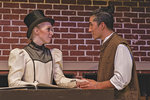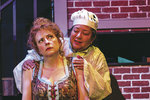Get ready for a new holiday tradition in the City of Dreams: a localized, lyrical and lady-led spin on “A Christmas Carol.”
Inspired by Charles Dickens’ 1843 novella, Key City Public …
This item is available in full to subscribers.
We have recently launched a new and improved website. To continue reading, you will need to either log into your subscriber account, or purchase a new subscription.
If you had an active account on our previous website, then you have an account here. Simply reset your password to regain access to your account.
If you did not have an account on our previous website, but are a current print subscriber, click here to set up your website account.
Otherwise, click here to view your options for subscribing.
* Having trouble? Call our circulation department at 360-385-2900, or email our support.
Please log in to continue |
|


Get ready for a new holiday tradition in the City of Dreams: a localized, lyrical and lady-led spin on “A Christmas Carol.”
Inspired by Charles Dickens’ 1843 novella, Key City Public Theatre’s (KCPT) pioneering production of “Spirit of the Yule” offers a new take on the timeless tale of transformation.
Written by Denise Winter and Linda Dowdell, it’s an original musical set in 1889 Port Townsend featuring a female Scrooge.
The play’s scenes take place predominately downtown on Water Street, in and around the Delmonico Hotel, run by the sharpshooting, rum-drinking Miz Maynard, the hotel’s sole proprietor now that her business partner, Jacob Marley, is dead.
(The Delmonico sign can still be seen above the front door of Expressions Apparel, 834 Water St.)
The audience also gets to take a trip uptown for a party at the Rothschild House and to attend a show at the Learned Opera House that features acrobatic antics, burlesque dancers and a musical ad for Coldwell Banker.
The show’s streets are populated by merchants, workers and, naturally, a few “fancy ladies” to keep the seamen happy as everyone waits in excited anticipation for the railroad that’s acomin’. “It’s wild out here,” the show’s opening number claims.
Winter, artistic director, and Dowdell, musical director, plan to make the show an annual affair. It’s already scheduled for the theater’s 2017 season.
“We want something where people can ‘share the joy,’” Winter said, referring to the musical’s closing number. “We hope you leave humming ‘Spirit of the Yule’ or ‘Share the Joy,’ and that these become new holiday traditions.”
WHY GO TO LONDON?
Winter came up with the idea for the show while serving on a subcommittee of the city’s Lodging Tax Advisory Committee. That subcommittee was dedicated to finding ways to draw tourists here in December.
“One of the things that Port Townsend was lacking specifically for the holidays was this big event that you know was going to happen every year, and that you plan for,” said Winter.
Winter has had great success with Shakespeare in the Park, which opens the first week of every August. The show has a following, she said, and out-of-town devotees plan their vacations around seeing the summer-evening performances in Chetzemoka Park.
For the winter season, Winter also wanted to establish an annually anticipated production.
“A Christmas Carol” was an easy answer. “Everybody knows it and people love it,” Winter said.
But how could she make it new? Winter first had the idea of making it an original musical. Then she thought about setting it in Port Townsend during the town’s early years – the same era in which Dickens’ story is set.
“Why go to London?” Winter asked. “Why not figure out how that story would happen here, in this town, at that time?”
SEARCHING FOR A SCROOGE
Winter pitched her idea to Dowdell, with whom she’s collaborated on many a musical.
Dowdell raised the possibility of a female Scrooge as a response to international concerns that there are few great roles for older women.
“Why not create a great role for a woman, especially a woman who isn’t a 20-year-old?” she asked.
Before they could proceed with writing a woman into this role, however, the creators had to determine whether she could have actually existed.
They approached JoAnn Bussa, a board member of both KCPT and the Jefferson County Historical Society.
Bussa had the woman for the job: Henrietta Maynard, a twice-divorced businesswoman who had run a hotel on Water Street during the boomtown era.
“JoAnn Bussa is a big fan of Henrietta Maynard,” Dowdell said.
“When our job became making Henrietta Maynard villainous, I think that was very difficult for JoAnn.”
But casting the character in an unfavorable light was essential: “You kind of had to, in order to tell the Dickens story,” Dowdell said.
Winter and Dowdell toyed with different ways to make her a villain – at one point considering the idea of her murdering one of her husbands – but ultimately they went back to the “Christmas Carol” plot for guidance.
“You have to care enough about this person to want to see them transform.” They wrote her as a mean-spirited woman who’s “all about land grabbing” and who holds something over everybody.
A significant element of Miz Maynard’s transformation into a kind woman involves her treatment of her “fancy ladies” – members of the world’s oldest profession who live upstairs in her hotel.
“Something that we found in our research was that these fancy ladies of the day were really the women who had, in a lot of ways, the most freedoms,” Winter said.
While married women couldn’t open property, those “who worked hard in a not-so-great industry” saved money to buy property, own businesses and help establish charitable organizations, Winter said.
She and Dowdell wanted to honor that part of history in the play’s storyline.
“It took this night of looking at her life’s history, and her potential future,” Winter said, “to help [Miz Maynard] see the path to being a catalyst for lifting more women up.”
WRITTEN IN A YEAR
The plot – and to a certain extent, the language – of “A Christmas Carol” provided the play’s structure, within which Winter and Dowdell developed the historical setting and characters, many of whom, like Henrietta Maynard, are based on real life.
To facilitate researching and developing a musical in a year, Winter set up a series of readings as part of the production process, the first one taking place in March during PT PlayFest 20.
“From the beginning, people were excited about the music, and they were excited about the concept of a woman as Scrooge, and they were excited about it being in Port Townsend,” said Winter.
While the play’s dialogue and music are rich with names, terms and places that will resonate with locals, Winter said people from out of town have also had a positive reaction to the show, “because it’s America’s story; it’s a pioneer story.”
“Everything has to take place somewhere,” said Dowdell, noting that people don’t have to live in Oklahoma to appreciate “Oklahoma!” the musical. “Like ‘Hamilton,’ [‘Spirit of the Yule’] is a fabulous way to learn history and really be interactive, and get people doing their own research,” she said.
Winter also noted how ideal this town – with a name that sounds like “town’s end” – is for a musical.
“If you’re not from here, you would think that we made up that town,” she said. “It writes itself; it’s such great material.”
“It doesn’t really write itself – come on,” Winter added, laughing.
CHARACTERS & CAROLS
“Spirit of the Yule” uses a small cast of nine playing more than 20 roles. While Angela Poynter appears as Miz Maynard only, the other actors rapidly change characters.
Often, the double casting is intentional, Winter said.
When the ghosts of the past, present and future appear to Miz Maynard, they’re somewhat recognizable, thus giving their appearance a “Wizard of Oz” aspect, Winter said.
Actor Patricia Willestoft transforms from a sedate Madame Maude to a secretive Ghost of the Past, Winter said. The joy of merchant Zee Hong (Consuelo Aduviso) bubbles over into an exuberant Ghost of the Present, and the dark Ghost of the Future (Tomoki Sage) evokes an earlier chant that will be familiar to the audience, Winter said.
Hewitt Brooks plays a land speculator and the woeful Jacob Marley.
Leah Finch is both a fancy lady and a hopeful young Henrietta Maynard in love with Lach-Ka-Nim (Sage) the son of Chief Chetzemoka. She also makes an appearance as Tillie, the wife of Miz Maynard’s nephew Fred (Noah Morningstar, who also plays a tree-cutter who flirts with the ladies).
Christa Holbrook plays a fancy lady and the role of Dorette Rothschild, and appears as the ailing Maddie Mae, the Tiny Tim to Blaine Lewis’ Bob Cratchit. Lewis also takes on the role of David C.H. Rothschild.
All the characters sing their way through the show, in solos, duets and ensemble pieces.
“The music kind of reflects the historical melodies through a contemporary lens.”
During the show, Dowdell leads the band on piano, with Mimi Grant playing violin and John Reid on drums.
Her original score is peppered with references to “Old MacDonald” and “Oh! Susanna”; includes a sea shanty; and uses the tune of a traditional melody (“Pretty Polly”) for a number titled “Miz Maynard, Miz Maynard.”
“I can get pretty carried away in a contemporary direction,” said Dowdell, but for this show she tried to stay close to folk and Americana music, although she does describe two songs (“I Mean Business” and “I’m in Business” sung by the older and younger Henrietta Maynard respectively) as “retro rap tunes.”
Quotes from both Port Townsend archives and Dickens’ text also became inspiration for songs, and classic Christmas carols are subtly woven into the score, generally as an underscore to add ambiance, said Dowdell.
SHARE THE JOY
The creators already have a few ideas of how the show may change for next year, although the idea is that the show would become a standard holiday tradition for Port Townsend and beyond.
Winter noted that while the production is rooted in the Christmas spirit, its messages are also universal.
“You don’t have to celebrate Christmas to enjoy this show,” she said. “What we walk away with is a story of hope and optimism.
“Part of the catalyst for [Miz Maynard’s] change is not just that she wants to live,” Winter said, “but that she wants to stay in the town and invest in the place that she loves.
“This town was built on hope and optimism – and this town continues to thrive because of everyone’s hope and optimism – it’s the City of Dreams.”